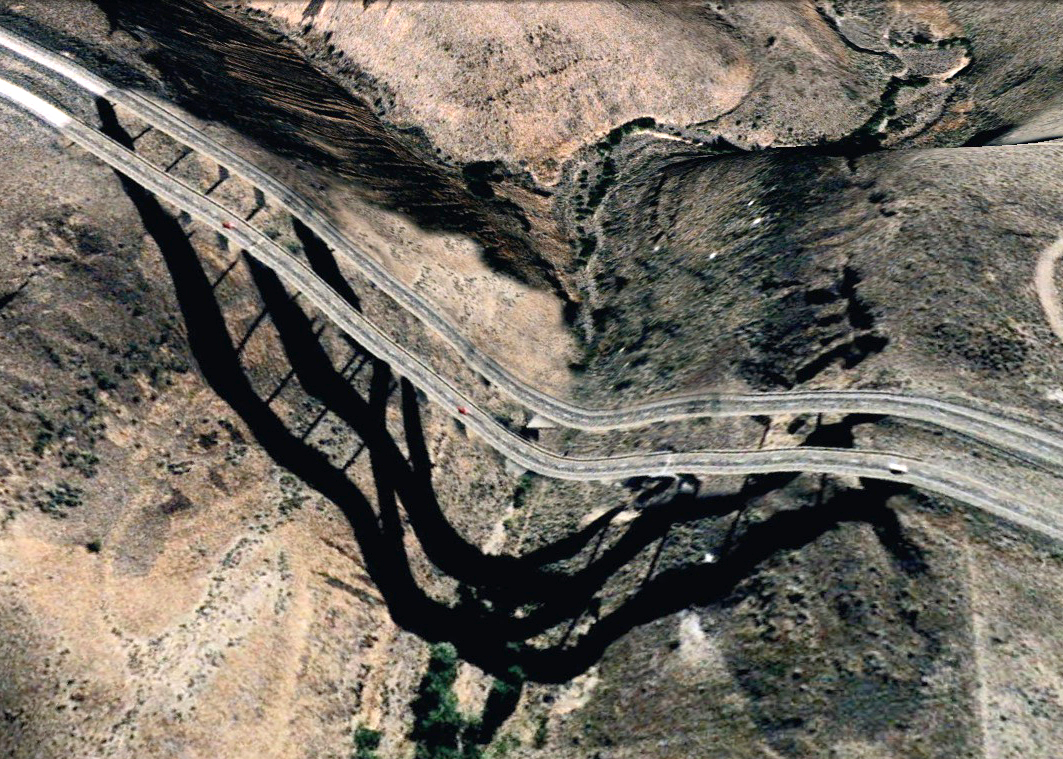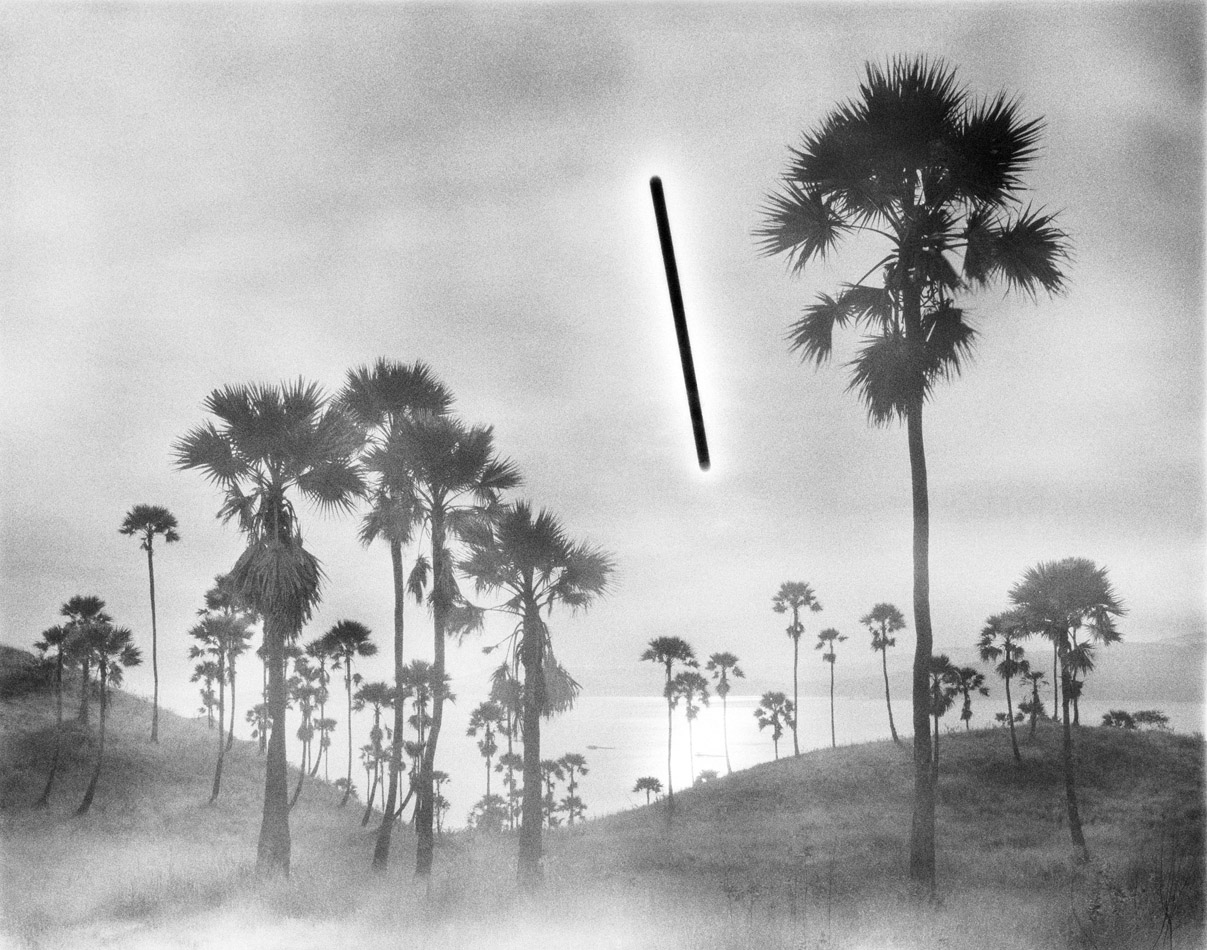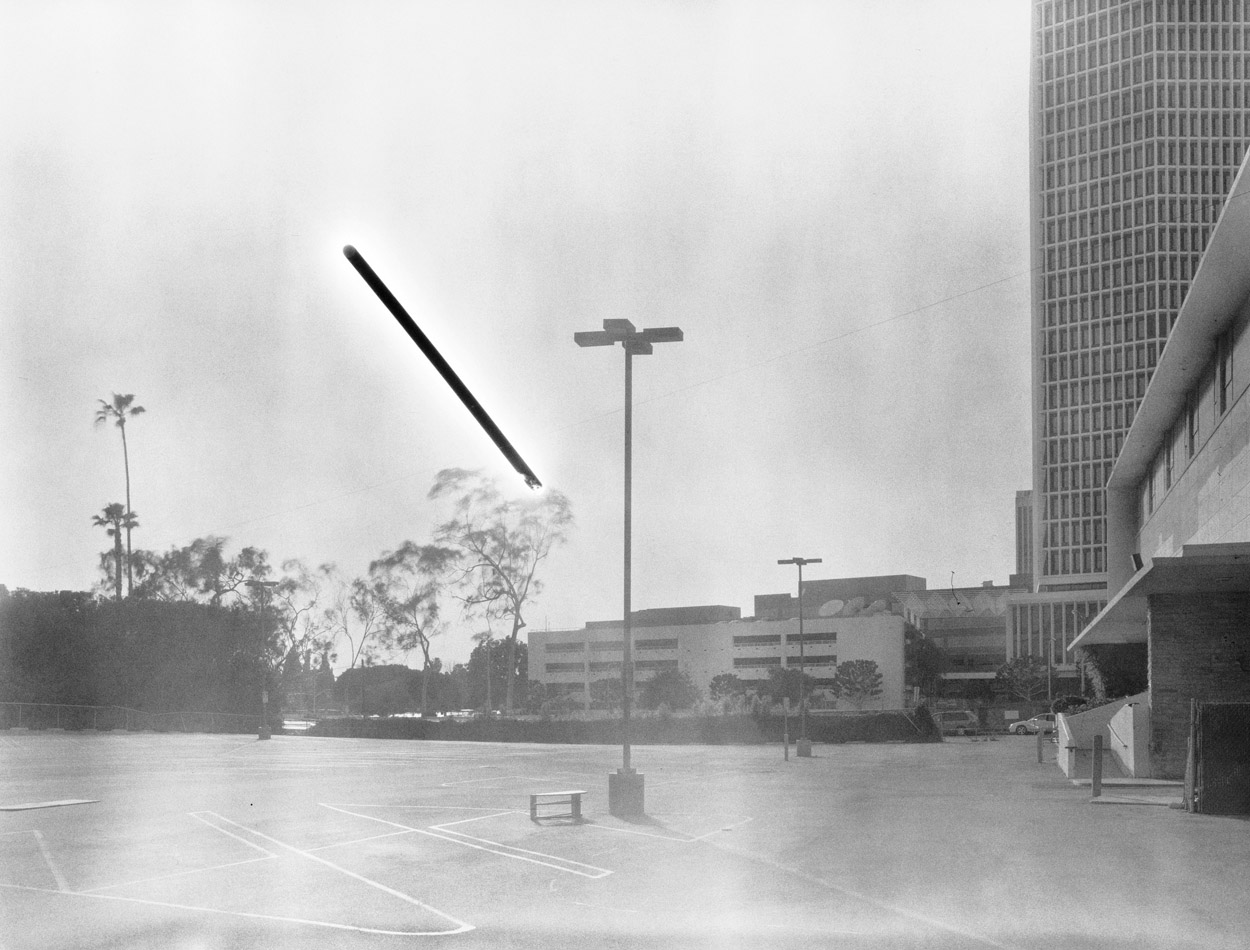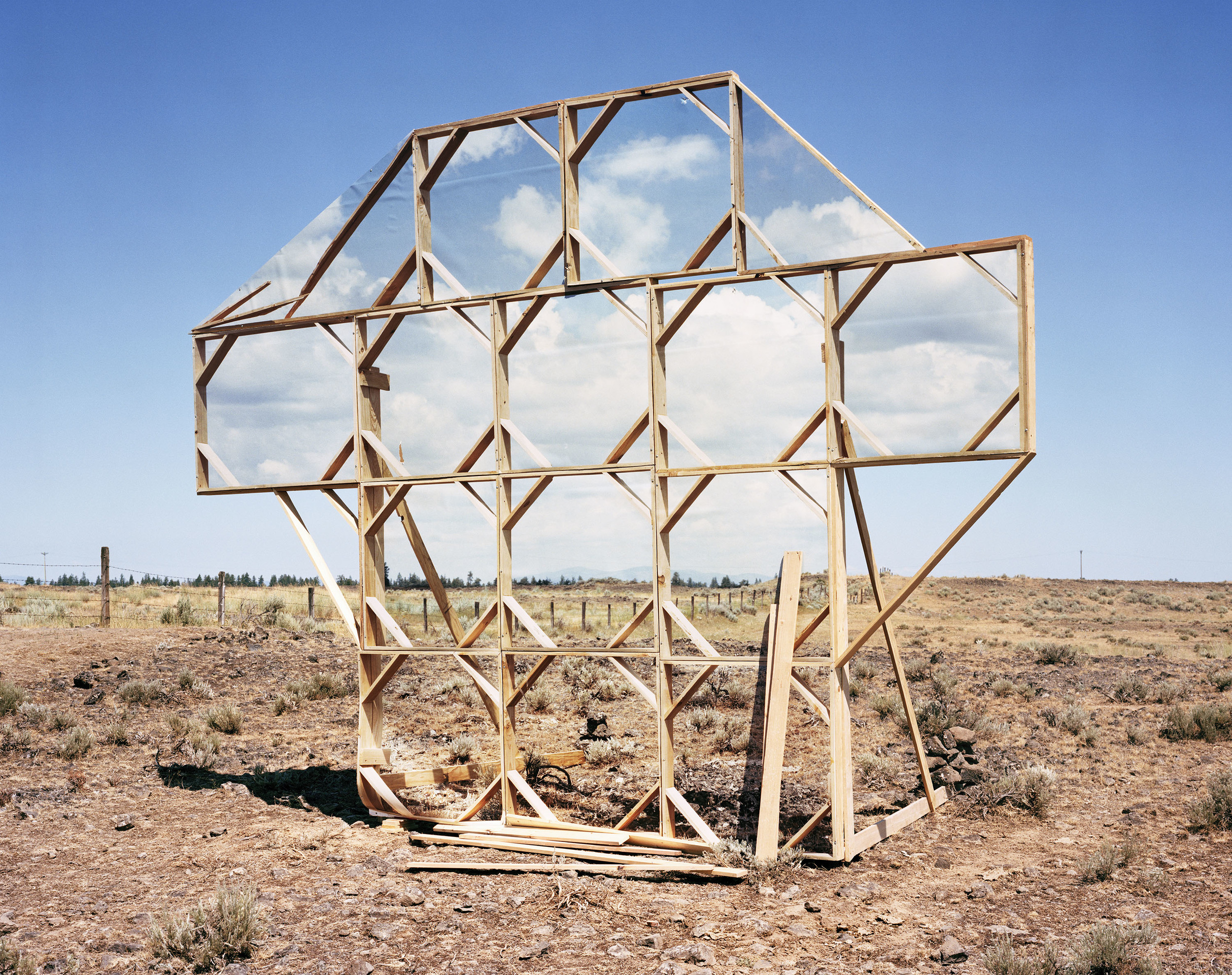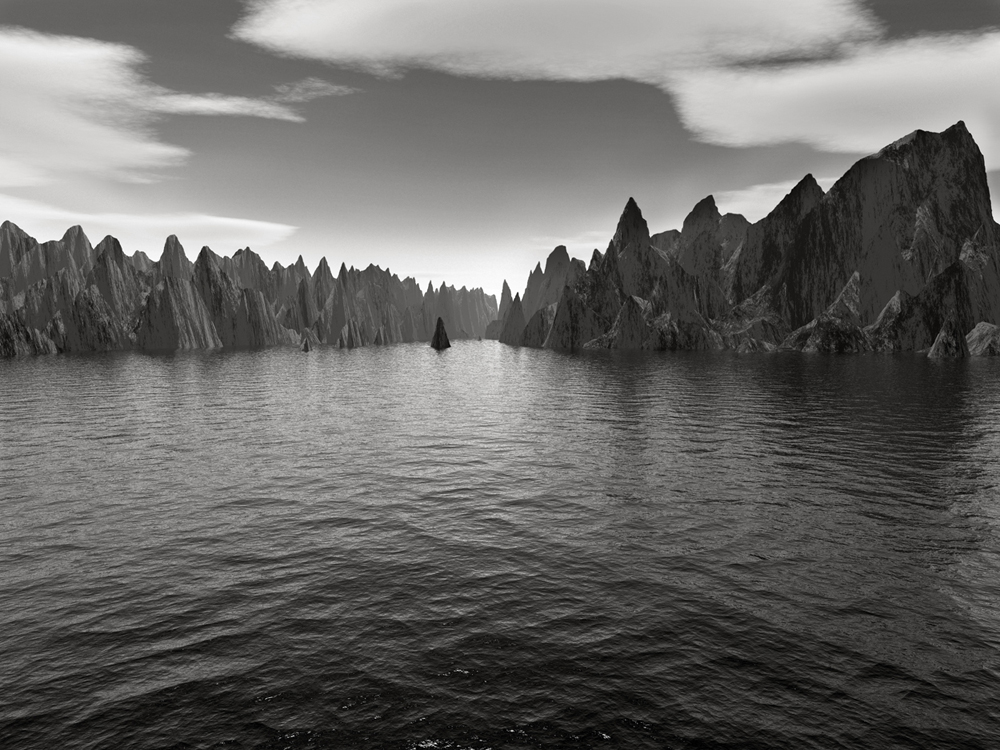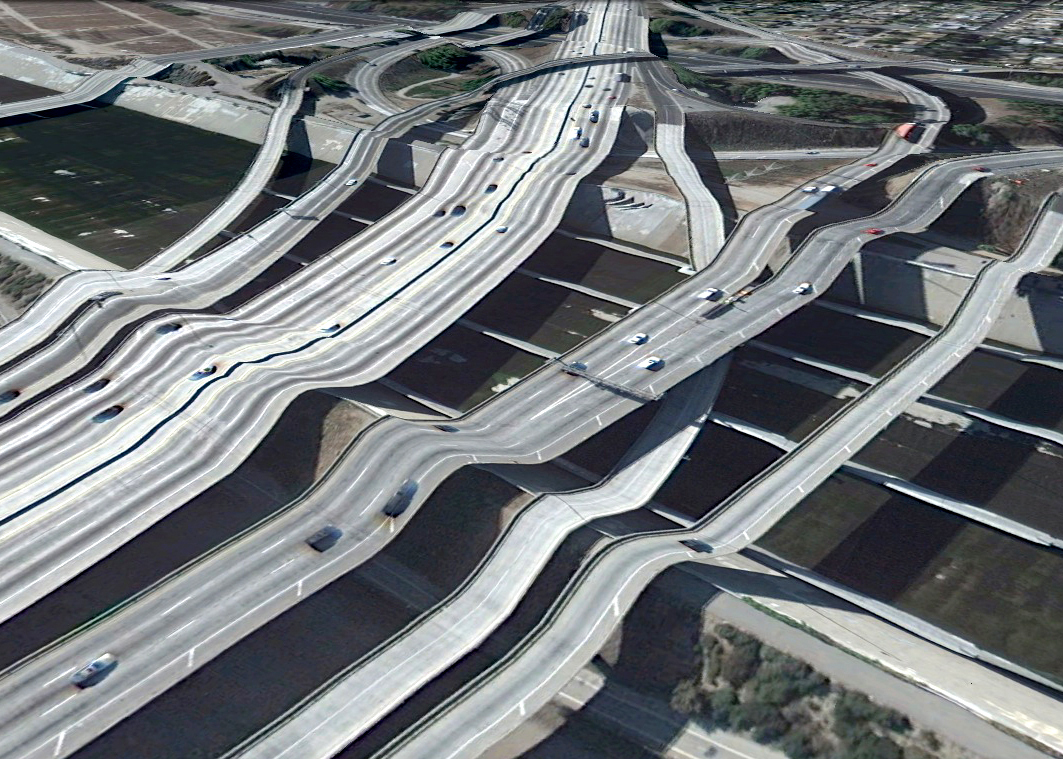 Google just won't stop popping up in the art world these days. After the much-hyped and thus far disappointing Google Art Project and several interesting photographic projects using Google Street View technology, the French artist Clement Valla has used Google Earth to create his Bridges series. The series began when Valla, who has worked as an architect and designer, noticed a bug in Google Earth's 3D view: while the software uses the altitude of the ground to create it's 3D renderings, it isn't accurate enough to pick up on bridges which find themselves warping and melting according to the contour of the surrounding landscape. The results remind me a little of Fontcuberta's Landscapes without memory, landscapes that seem only to be possible in a computer's imagination.
Google just won't stop popping up in the art world these days. After the much-hyped and thus far disappointing Google Art Project and several interesting photographic projects using Google Street View technology, the French artist Clement Valla has used Google Earth to create his Bridges series. The series began when Valla, who has worked as an architect and designer, noticed a bug in Google Earth's 3D view: while the software uses the altitude of the ground to create it's 3D renderings, it isn't accurate enough to pick up on bridges which find themselves warping and melting according to the contour of the surrounding landscape. The results remind me a little of Fontcuberta's Landscapes without memory, landscapes that seem only to be possible in a computer's imagination.
Interview: Christian Schink, A different kind of discovery
 Hans-Christian Schink's latest series 1h is a real departure from the formal precision of much of his previous work and a delightful return to the essence of photography. The series has just been released in book form by Hatje Cantz (this one cannot have been easy to print!). Some of the works from 1h are currently on show at the Kicken Gallery in Berlin until 16 April. This interview was done for the latest issue (#6) of the excellent Fantom magazine based in Milan and New York.
Hans-Christian Schink's latest series 1h is a real departure from the formal precision of much of his previous work and a delightful return to the essence of photography. The series has just been released in book form by Hatje Cantz (this one cannot have been easy to print!). Some of the works from 1h are currently on show at the Kicken Gallery in Berlin until 16 April. This interview was done for the latest issue (#6) of the excellent Fantom magazine based in Milan and New York.
Marc Feustel: I'd like to start by asking you how the idea for this project first came about? It seems to be a significant departure from your previous work in terms of your visual approach.
Hans-Christian Schink: I first used solarization in one of my works in 1999 when I was invited to submit a work to the Department of Physics and Astronomy at the University of Jena. I submitted a piece made up of three panels with abstract color gradations of a sky during the day, a sky at night, and the path of the sun, which appears as a solarized, black line on a white background. I got the idea from a Hermann Krone photograph from 1888. Unlike Krone, I pointed my camera straight at the sky in order to get a clean, linear image of the sun. I didn't pursue this theme at the time as I was focusing entirely on my series Verkehrsprojekte Deutsche Einheit (Traffic Projects German Unity). Later, on a trip to the Mojave Desert in California in 2003, I was so fascinated by the landscape and the blazing light that I wanted to find a way of reproducing this almost unreal impression. I remembered Minor White’s photo, Black Sun, of a winter landscape where the sun appears as a solarized black dot—an accidental effect created when the camera shutter briefly froze. I wanted to try to use this effect with a longer exposure, but I wasn’t sure if any of the landscape would be recognizable at all. I didn't work persistently on the idea at the time: I was busy with other projects and wasn't sure that it was possible to construct a solid concept from what was quite an atypical approach for me. I was also still dealing with different technical and contextual issues. Most importantly, though, I wasn't sure that the project could become something more than a technical game.
MF: What was it that convinced you could turn the project into something more than a technical exercise?
H-CS: It was a question of the atmospheric power of the image. To me, the Hermann Krone picture was the document of an experiment: it only contains the line of the sun and a faded rooftop silhouette. My first test photos didn't look very different. But when I found a way to balance out the aesthetic power of the landscape with the dominating phenomenon of this mystical black line, I knew it would work.
MF: The project seems to deal with the very essence of photography: drawing with light. These sun traces seem like the most primitive manifestation possible of this. Was this project a way for you to explore the basic components of photography, light and time?
H-CS: Yes, absolutely. And in a very unusual, almost abstract way. I was able to reproduce the light of the sun and the passage of time without them being recognizable as such at first glance. The pictures show a completely different reality of their own that can only be perceived through photography. This touches on one of the key issues of the medium: the ability to depict reality.
MF: The relationship to reality is a very interesting component of these photographs. Although the landscapes are real, the black trace of the sun makes us question the reality of these images. In general, it seems that photography's link to reality has become more and more hazy with technological developments in recent years. Do you think that people would still be as attached to photography if it were no longer perceived as a document of reality?
H-CS: I don't think of photographs as documents of reality. Even if they are taken from reality, to me photographs are beyond reality, in either a positive or negative sense. Looking at hundreds of holiday snapshots taken with enthusiasm during a trip to an exotic location, you will most likely realize that these images do not translate the atmosphere of that place at all. Your own experience of reality is far from what's depicted in a photograph. On the other hand, in a photograph as a work of art you will always find more than you can actually see in the picture. It will create it's own kind of reality.
Of course, the presumed link to reality is still one of the most important aspects in photography. Even if we know that a "photographic" image is completely digitally composed, it somehow appears to be a document of reality. It's a matter of perception versus knowledge and I don't think this tension is going to weaken.
MF: I’m interested in the very particular aesthetic of the images. The long exposures give the pictures a very particular feel, like faded nineteenth century travel photographs where the chemistry has changed over time. Did you have something specific in mind when you started or was this just the result of the complicated long exposure process?
H-CS: It was a result of the process. I just needed to understand that this particular aesthetic is essential to the work. I realized that the technical imperfection was a benefit, not a drawback, that it gives a certain 'back-to-basics' impression. The whole project was about accepting conditions that were completely different from my previous projects.
MF: The black trace of the sun has a great democratising power. All of the landscapes, no matter how dramatic, beautiful or iconic appear to be dwarfed by this primitive trace or scar in the sky. The chemical inversion of sunlight from white to black also seems to reverse the properties of the sun. It is no longer life-giving, warm or nourishing, but rather becomes brutal, stark, and even creates a sense of melancholy.
H-CS: I agree and I'm quite happy that the results turned out that way because that was what I was hoping for. Though, one of the many ambiguous aspects of this project is that the atmosphere of the image is so different from the one when taking the picture. The hours I spent waiting next to the camera, often just observing the landscape while the sun did its job, were fascinatingly intense, sometimes unforgettable experiences… among the best experiences I’ve had in my work up to now.
MF: How did you decide on the 1h timeframe for the exposures?
H-CS: I started with timeframes of 10, 20 and 30 minutes, always curious as to the effect this extreme overexposure would have on the visibility of the landscape in the picture. I was surprised by the results and so I finally settled on an exposure time of one hour, since it’s the most commonly used unit of time. Dividing time is the human way to deal with eternity.
MF: I’m interested in the disconnect between these photographs and your experience when capturing these images. Of course you cannot look directly at the sun, let alone watch it inscribe its path in the sky over one hour. Can you describe your experience observing these landscapes while waiting for your camera to capture the trace of the sun?
H-CS: At the early stage of the project I always felt a little nervous during the one hour of exposure time, concerned about the result. Over time I learned to accept that once the cameras are set, the result would be beyond my power anyway. Given this, I became much more relaxed. I developed a kind of laid-back stoicism and was able to enjoy the situation, to enjoy the sunlight, which was of course warm and nourishing then. Even at locations in L.A. or Tokyo for me there was this atmosphere of calm and quietness. And in some particular places like in the Algerian or Namibian desert this experience became really amazing. There were moments of contemplation when I started to sympathize with the idea of worshipping the sun.
MF: When you began the project in the Mojave desert I believe that you initially intended to shoot it in a single location. What made you decide to extend the project across the globe?
H-CS: One of the most fascinating aspects of the experimental phase before I actually started the project was exploring how the angles of the sun line varied according to the latitude of each location. As a result of this variation, I decided to expand the project to cover the whole world and therefore began checking to see if the destinations I had already selected would be suitable locations for this series. At the same time I also started looking for places that fulfilled certain criteria, for example I wanted a photo from the northernmost and southernmost points that could be reached with a reasonable amount of effort. I also wanted a picture of the midnight sun, photos from places along the Tropic of Cancer and Tropic of Capricorn taken during the solstice, a picture shot from as close to the equator as I could get, and one taken along the International Date Line.
MF: The sun is a universal symbol which has deep cultural and religious connotations that differ around the world. Was this something that you considered in choosing the different locations?
H-CS: Yes, in the beginning. Actually I was thinking of going to Egypt for example, but then it would have been almost impossible to avoid photographing at locations related to the sun as a religious symbol. The next question would have been why choosing only one specific location since there are so many other sun-related places all over the world. The focus would have turned too much to human culture and religion.
MF: You chose to focus not only on natural landscapes but also on some urban locations. What made you decide to include these cityscapes alongside the more dramatic natural landscapes in the series?
H-CS: It was important for me to show that this phenomenon occurs everywhere, not only in landscapes far from civilization. The power of the sun is present all over the globe. However, it was extremely difficult to find urban settings with no visible "life", with no or few people, no cars going by in front of the camera causing reflections that would have distracted the viewer's eyes from the line of the sun. In the beginning I also photographed in places that were easily recognisable, such as Downtown L.A. or the Reichstag in Berlin, but finally decided not to use them, for the same reason.
MF: You have referred to the connection of this project to nineteenth century travel photography. Today it seems that the sense of discovery in travel has all but disappeared, there are virtually no places left to discover. I was struck by the fact that your series revives the sense of discovery by showing us the world in a way that cannot be seen by the naked eye.
H-CS: It's a different kind of discovery. I like the idea that this discovery can take place everywhere, you don't even have to travel to experience it. But I did, and it was my goal to show the world in a way that cannot be seen by human eyes.
MF: In the book, you include a map detailing the itinerary that you took to shoot the series. I was interested in the fragmented nature of this journey: it is not a round the world trip but a series of individual trips which extend out over time from your home in Germany. How important was the journey process for you in making this series?
H-CS: The final journey I made to complete the project was actually a three-month around-the-world trip. After all the single trips undertaken to get to a particular destination I thought it would made sense for the final journey to literally follow the sun on its way around the earth. Knowing the facts of modern astronomy, I think this geocentric perspective is still the way we look at this phenomenon up in the sky.
MF: The captions to your images provide details of the date, exposure time and coordinates where the image was taken. This information is at once very specific, scientific even, and yet it reveals nothing to us about the subject or location of the photographs. Why did you decide to use this information for the captions and to omit the names of the places where you were taking these photographs?
H-CS: Since the photos are not about the individual locations per se, I decided not to mention the places in the title, because they would always evoke some sort of visual association. I also like the contradiction between the fact that the title of each work gives the most precise information possible about the location but nobody knows where it is. We still rely on names to imagine a place, even if our imaginations don't reflect the reality of that place. I also enjoy the contradiction between the fact that the images seem to show something completely beyond human control, something out of this world, but if you check the coordinates with Google Earth, within a few seconds you're looking down from above like a god on the exact place where the picture was taken.
Interview: Chris Engman, Freedom, possibility and a desire for purity
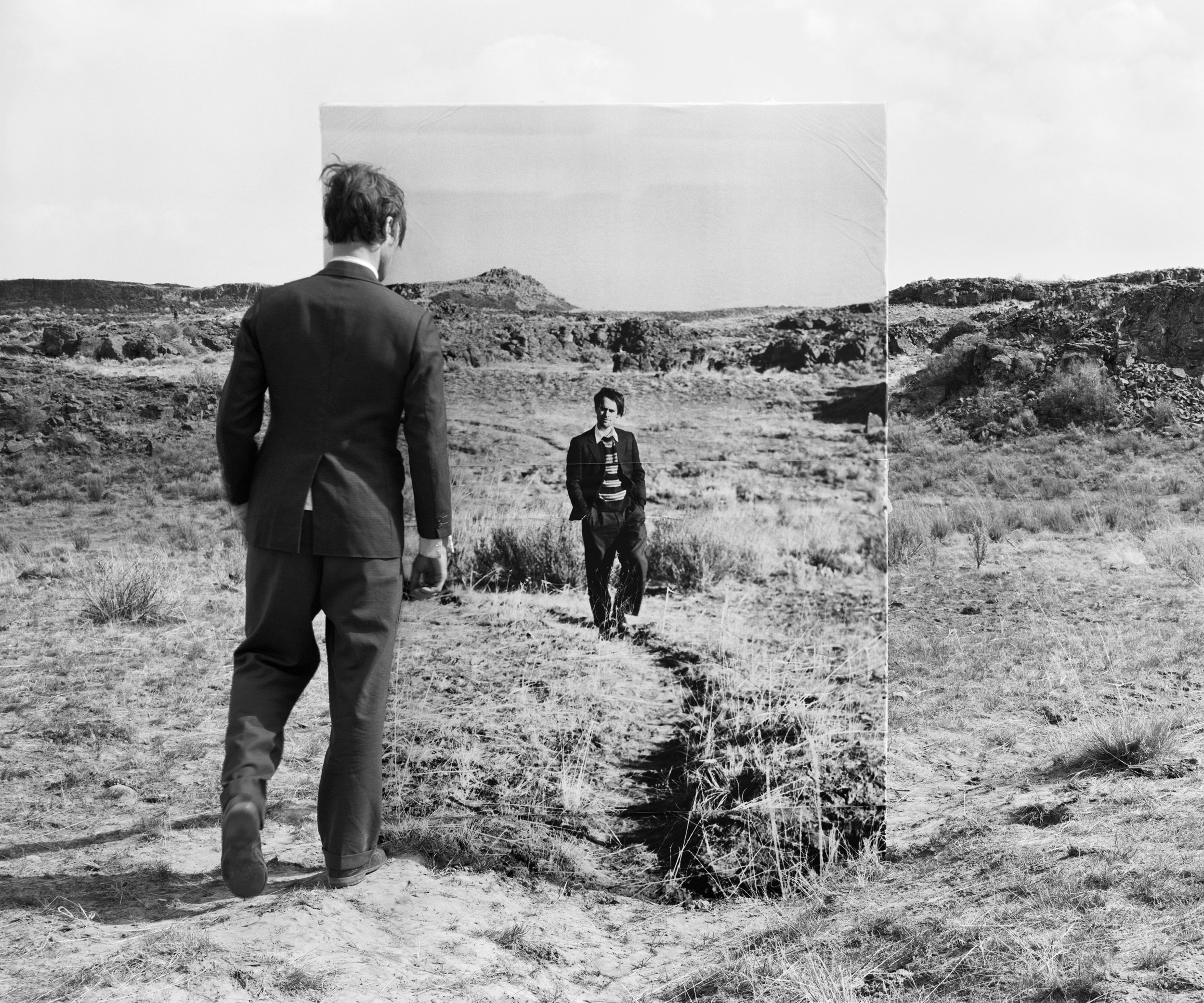 Chris Engman's series Landscapes is based on the vast open spaces of Washington State outside of Seattle, where Engman lives. The title of the series, just like the images themselves, suggests one thing, while revealing many others. He has a show on at the Greg Kucera Gallery in Seattle until Christmas Eve 2010. This interview with Engman was done for the Talent Issue (#24) of Foam magazine which came out in September 2010.
Chris Engman's series Landscapes is based on the vast open spaces of Washington State outside of Seattle, where Engman lives. The title of the series, just like the images themselves, suggests one thing, while revealing many others. He has a show on at the Greg Kucera Gallery in Seattle until Christmas Eve 2010. This interview with Engman was done for the Talent Issue (#24) of Foam magazine which came out in September 2010.
Marc Feustel: What attracted you to the landscapes of eastern Washington that you use for your photographs?
Chris Engman: When I set out to make a photograph I begin with an idea. I write about it, turn it over in my mind, and gradually the requirements for a site take shape. I then go out and drive, sometimes for a long time, until I find that site. The idea is not a response to the landscape; in my work the landscape is a response to the idea. Once I’ve found and used a site I become attached to it, and there are some that I frequently revisit. They go from being spaces where I am free to let my imagination wander to being places with a personal history and familiarity. I have dreams about buying up all that land and doing nothing with it so that it will be left alone.
MF: You refer to these landscapes as resembling ‘an unformed dream or empty canvas waiting to be acted upon.’ What made you want to intervene in these landscapes?
CE: They fulfilled the requirements for the illustration of my ideas. When I refer to these spaces as an empty canvas I mean that they are relatively free from distracting associations, so that the work can just be the work. Undeveloped land, ocean views, deserts, the associations they have are ones that are appropriate to the work: freedom, possibility and a desire for purity.
MF: The Japanese photographer Naoya Hatakeyama has suggested that ‘nature is already so distant from us that you might say it has become a fantasy’. Is this an idea that resonates with you?
CE: I don’t personally feel more distant from nature than I want to be. My work affords me a lot of opportunities to be in nature and for adventure and misadventure. Being and working in extreme places connects me to nature by confirming the power it has over me. I don’t really imagine that there is such a strict division between man and nature. We are a part of nature, when we harm it we harm ourselves.
MF: Can you describe how you go about constructing your images? The process seems quite elaborate.
CE: Every image presents unique challenges. In the case of Equivalence, to begin with I found a suitable piece of private land and got permission to use it. I built a frame and photographed it. Back in Seattle I made fifteen large prints altogether measuring 4.5 meters wide and over 3.5 meters high. The prints had to be skewed digitally to account for the fact that the frame was not parallel to the film plane. I returned to eastern Washington and placed the prints back onto the same frame. In the final photograph you wouldn’t know by looking at it that the prints were ever skewed be cause the camera, replaced to its original location, skews them again back into ‘correct’ perspective. The piece is titled after the series of clouds by Alfred Stieglitz, in which he suggests that his images of clouds can represent inner states and emotions. My version asserts that photographs are not objective and can only ever tell partial truths, and beauty and emotion are constructs of the mind. For me this doesn’t lessen photography, beauty or emotion but makes them all the more interesting.
MF: Manipulation in photography is not new, but digital technology has extended the range of possibilities and the line between straight and manipulated photographs is increasingly blurry. Do you think people’s perceptions of what a photograph is are changing as a result?
CE: One question I get a lot is are they manipulated? The answer is supposed to be no, they are ‘real.’ This is a false dichotomy. All forms of representation are manipulation. But the question gets asked, and at the root of it is a desire for authenticity. What needs to be better understood is that sometimes even heavily manipulated images are truthful and sometimes straight photographs tell lies, so there should be a different set of criteria for authenticity. My own photographs are in many ways closer to what is meant by straight than not. That is, the majority of the digital manipulation that I do could have, at least theoretically, been done in a darkroom. However, I have no qualms about crossing that line when necessary. In The Haul, for example, street signs and text on the buildings have been removed so that the place would have a more generic quality. One thing I will not do is pretend I did something that I did not do. Many photographers are finding ways to make their work be less work, while I have gone in the opposite direction. My photographs are laboured, and they don’t take short cuts. In that sense I am like a sculptor or installation artist who uses photography as a tool.
MF: I am curious to know about your influences and in particular your relationship to landscape photography. Your work occupies quite a unique space and it seems to integrate many different photographic and artistic traditions.
CE: I think a lot about Robert Smithson’s work relating to time and place. The Earthworks artists often have more in common with my process and practice than do landscape photographers. I enjoy the work of Michael Heizer and Walter De Maria, Georges Rousse and Robert Irwin. The re-photographic work of Mark Klett has been an influence recently. Fiction by writers such as Milan Kundera, Salman Rushdie, Gabriel Garcia Marquez, Faulkner and Hemingway often directly spurs ideas for particular photographs. Also the writings of the neurologist Oliver Sacks are an influence.
MF: As opposed to many contemporary landscape photographers your photographs don’t seem to have a direct message about the relationship between man and nature. Do you consider that there is a political aspect to your work?
CE: I am a political person but my work is not directly political. A lot of contemporary landscape photography is concerned with human exploitation of the landscape, usually with a pessimistic or nostalgic undertone. Although I am of course concerned about exploitation, the subject of my work concerns abstract ideas relating to perception and the human condition. On the other hand a few of my works do contain some subtle social criticism. One way to read The Haul, for example, is as a questioning of consumerism and the ideas about success that drive us to always want more and do more and never be content. The piece expresses a desire to travel through life with a lighter load.
MF: What are you working on at the moment?
CE: The piece I’m working on is a diptych called Dust to Dust. My plan is to find or make a large pile of sand or dirt and photograph it. For the second part of the diptych I will employ land-moving equipment to rotate the pile ninety degrees clockwise. The mountain of dirt will be reformed in its original shape, the shadows will be repeated with careful timing and camera placement. In this way the pile of dirt will appear to remain stationary while the landscape itself will appear to have moved. The piece is a meditation on impermanence and the fact that not only existence but even the features of the physical world are temporal and will come to an end.
Interview: Joan Fontcuberta, Landscapes without memory
 I first came across Joan Fontcuberta's Orogenesis series when I picked up a copy of the Landscapes without memory book in Arles last year. The series is deceptive; these aren't photographs but computer-generated images created by software renderers that are designed to produce 3D images based on cartographical data. Fontcuberta decided to explore the possibilities of the technology by feeding it misinformation: instead of giving it a map to read, he fed it the visual data contained in famous paintings or pictures of different parts of his anatomy. The results are these "landscapes without memory."
I first came across Joan Fontcuberta's Orogenesis series when I picked up a copy of the Landscapes without memory book in Arles last year. The series is deceptive; these aren't photographs but computer-generated images created by software renderers that are designed to produce 3D images based on cartographical data. Fontcuberta decided to explore the possibilities of the technology by feeding it misinformation: instead of giving it a map to read, he fed it the visual data contained in famous paintings or pictures of different parts of his anatomy. The results are these "landscapes without memory."
The thing I like the most about Fontcuberta is his ability to explore philosophical questions on the nature and contemporary practice of photography while remaining engaging and frequently hilarious. I did this interview with him for the Landscapes without memory exhibition which has just opened at Foam in Amsterdam (until 27 February 2011).
Marc Feustel: How did you first encounter photography and what was it that attracted you to the medium in particular?
Joan Fontcuberta: It was in high school. Our art history teacher was a photo amateur and set up a darkroom for his pupils. The magic of photo processing immediately fascinated me. My father ran an advertising agency and I was also very curious about the world of models, photographers, filmmakers and so on. During the holidays I spent time watching and learning at the agency. Later on I joined the creative department of the agency and worked there for three years. At the same time I was studying at university: sociology, communications, semiotics… With that background what used to be an exciting passion became a more serious thing: a way to understand my physical and cultural environment.
MF: You have said that photography should not only be taught in fine art schools from an aesthetic perspective but in the context of philosophy as a tool for critical thought. In your view, is this critical thought something that is lacking in contemporary photography?
JF: I have noticed a perverse phenomenon in contemporary art: artists abdicate their discourse to critics and curators. Their work then just becomes an illustration of someone else’s discourse. Maybe that is the price they have to pay to achieve some form of recognition in the art scene or market. Luckily there are exceptions. Presently I am very curious about ‘found’ and ‘trash’ photography and could mention the names of Joachim Schmid, Penelope Umbrico and Erik Kessels. There are many other intelligent, radical voices in other approaches as well… I am optimistic. Regarding critical thought, Marcel Proust said: “Le véritable voyage de découverte ne consiste pas à chercher de nouveaux paysages, mais à avoir de nouveaux yeux.” (“The true voyage of discovery does not consist of searching for new landscapes, but of having a new pair of eyes.”
MF: The images in Landscapes without memory are created by using three-dimensional imaging software designed to render landscapes based on maps. Can you explain a little about the process for making these images and how you discovered the software that you used to make them?
JF: I used several 3D renderers (if you search Google you will find dozens of them). I discovered them in the Banff Center for the Arts, in Canada, in 1994, where I was invited to lead an art residency on the concept of “The Transient Image”: an international gathering of visual artists exploring the mutations of technological image making. There I learned about virtual reality technologies and became fascinated by the possibilities they offer to build illusionary spaces. It was an ironic paradox that a center located in a national park in the Rocky Mountains, surrounded by such magnificent virginal nature, went to that much effort creating virtual models of invented nature. In any case, all this software functions on the same principle: cartographic data is translated into a 3D relief. However, I deceived the computer and instead of inputting a map, I input a masterpiece of landscape painting or photography. The software is constrained to output a landscape, whatever the input. It must produce an image within a vocabulary of limited terms: mountains, volcanos, valleys, rivers, oceans… And this is the point: a landscape is recycled into another landscape. This subversion unveils another gesture: we make computers to produce hallucinations, we push technology to let its own unconscious emerge.
MF: Since the New Topographics, landscape photography has occupied a growing space in the world of fine art photography. But contemporary landscape photography seldom depicts the beauty of 'natural' landscapes, like the work of Ansel Adams for example. Is there still a place for photography that celebrates the beauty of the natural landscape?
JF: This is a debate about beauty within aesthetic categories. Of course there is a place to celebrate the beauty of the natural landscape—as currently happens in postcards and calendar plates. The question is which kind of beauty are we interested in? Should art just provide visual pleasure or should it rub our eyes with sandpaper to disturb our conscious and provoke a reaction? The philosopher Eugenio Trías believes that the sublime substituted beauty, and that the sinister has then substituted the sublime. This notion of sinister derives from Freud’s “Umheimlich” and refers to a sense of distortion and oddity. I wonder if we are now experiencing a mutation towards a new, hybrid category. I have in mind a sentence by Picasso: “The ugly may be good; the beautiful will never be”. He meant that something considered beautiful conforms to a standard taste, whereas something considered as ugly may confront our present sensibility and bring out a new one.
MF: Contemporary landscape photography often focuses on the tension between man and nature. However what we are seeing in this series appears to be ‘pure’ nature, with no trace of man whatsoever, and yet these images are entirely artificial, a man-made fantasization of nature. How did you develop the approach to this series?
JF: Many of my projects deal with landscape, or how landscape should be understood today. For instance, in Securitas I borrow keys from people and project them onto photographic paper. The result is a horizontal line simulating a mountain ridge. It is a minimalist idea which epitomizes the essence of landscape as related to safety and property. Thus landscape can be defined by ideological and political approaches, rather than aesthetic ones based on a resemblance to nature.
Now let’s go back to the roots of landscape as an autonomous genre. Until the seventeenth century, natural space was just a subordinate background for portraits or historical scenes. The birth of landscape inverted the established visual order of things, giving priority to that which had been traditionally considered merely as escenography. Landscape painting has only been recognized quite recently, when artists achieved the right to contemplate nature without the justification of human anecdotes. To contemplate nature without, let’s say, being seen. In my Orogenesis landscapes nobody looks at us, they are brand new and consequently exempt of human experience. On the other hand, they constitute a sort of postmodern statement: they illustrate that the representation of nature no longer depends on the direct experience of reality, but on the interpretation of previous images, on representations that already exist. Reality does not precede our experience, but instead it results from intellectual construction.
An additional concern in Orogenesis is artificiality and more precisely artificial nature. Let’s ask ourselves the question: could a natural nature exist? The answer is no, or at least, not anymore: man’s presence makes nature artificial. Until the sixth day, Creation was natural, but at the seventh it turned into an artifice.
MF: With the proliferation of digital technology, more still photographs are being made than ever before, despite advances in other media like video. Do you think that people would still be as attached to photography if it were no longer perceived as a document of reality?
JF: Yes, certainly. Photography is dissolving into the magma of images. It is losing its historical specificity, but is beginning to fulfil other functions. I just published a book titled Through the Looking Glass about cell phone photos and their circulation through the Internet and online social networks. Teenagers are not interested in photographs as documents but as trophies. When Martians finally invade the Earth, green lizard-shaped aliens will emerge from their spacecrafts. They will fire at us with laser guns but we won’t hide nor protect ourselves. We’ll take our cell phones and we’ll photograph them to prove that we saw them, to prove that we were there when they arrived.
MF: Interestingly all the images in Orogenesis depict incredibly dramatic, over-the-top landscapes. Is the software capable of depicting an unremarkable landscape, like an empty field or a barren wasteland?
JF: Sure. However if you keep the default settings the software is endowed with an unconscious model oriented towards spectacular landscapes, something that should make us reflect on its inherent ideology. There is a glorification of the mountains as symbols of spiritual achievement and purification. I exaggerate that feeling because the resulting wild and imposing landscapes must be read as a parody. Somehow that excessive sense of drama leads to a sense of kitsch, or is reminiscent of the ahistorical landscapes of computer games through which players travel in search of predetermined adventures.
MF: Can you explain a little about the significance of the title ‘Landscapes without memory’ and the absence of memory in these landscapes?
JF: There has been a common strategy in contemporary art focusing on landscape as depictions of territories where a tragic event occurred in the past. The place is presented metonymically as a remnant of the event itself, it wouldn’t interest us without the history behind it. So usually landscapes exist because they hold those layers of memory. However, Orogenesis displays landscapes beyond the influence of time, frozen in an uncertain geological age, without any trace of culture or civilization. There is no echo in them, no voices or shouting that have vanished into the continuity of life and oblivion. There is nothing to commemorate there, nothing to remember. A kind of ‘degree zero’ terrain. Thus, they are landscapes without memory—well, with the exception of the memory of art.
MF: Humour is less obviously present in this series, but in general it appears to be an important aspect of your work. What role does it play in your photographic practice?
JF: Let’s go back to classics: “Castigat ridendo mores” (“One corrects customs by laughing at them”): that was the Latin motto for comedy. I belong to a Mediterranean hedonist sensibility—which might be the contrary of a Calvinist one. There is an illustrative folk saying: “Good girls go to Heaven; bad girls go to everywhere”. Humour is not only an ingredient to enjoy life, on the same level as good weather, wine, sex and fiesta as the cliché goes. A great deal of contemporary art is too solemn and boring. In my work humour is like a filter trying to put forward serious proposals but in an appealing and exciting manner. Laughter is a revolutionary impulse, the great antidote to the poisons of the spirit. As Nietzsche said: “We should consider every day lost on which we have not danced at least once. And we should call every truth false which was not accompanied by at least one laugh”.

